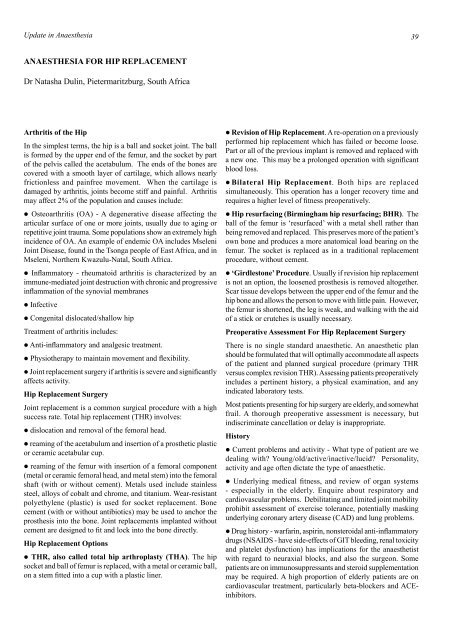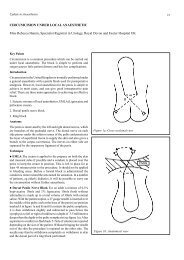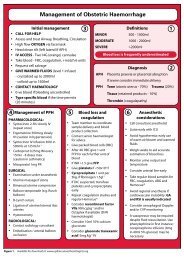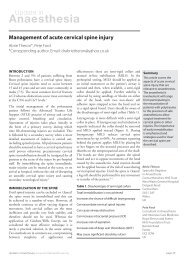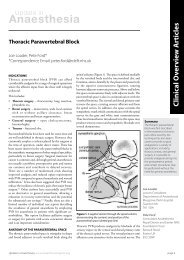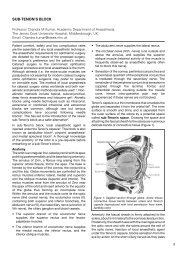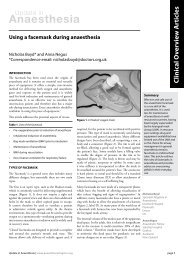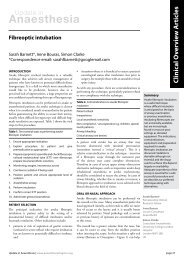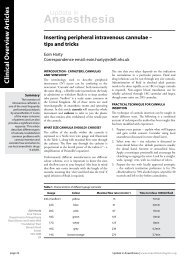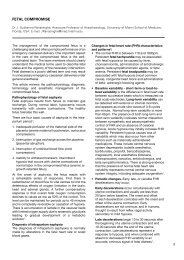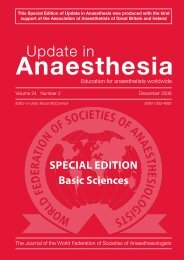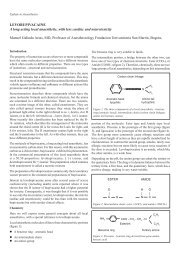Anaesthesia For Hip Replacement - Update in Anaesthesia
Anaesthesia For Hip Replacement - Update in Anaesthesia
Anaesthesia For Hip Replacement - Update in Anaesthesia
Create successful ePaper yourself
Turn your PDF publications into a flip-book with our unique Google optimized e-Paper software.
<strong>Update</strong> <strong>in</strong> <strong>Anaesthesia</strong> 39<br />
ANAESTHESIA FOR HIP REPLACEMENT<br />
Dr Natasha Dul<strong>in</strong>, Pietermaritzburg, South Africa<br />
Arthritis of the <strong>Hip</strong><br />
In the simplest terms, the hip is a ball and socket jo<strong>in</strong>t. The ball<br />
is formed by the upper end of the femur, and the socket by part<br />
of the pelvis called the acetabulum. The ends of the bones are<br />
covered with a smooth layer of cartilage, which allows nearly<br />
frictionless and pa<strong>in</strong>free movement. When the cartilage is<br />
damaged by arthritis, jo<strong>in</strong>ts become stiff and pa<strong>in</strong>ful. Arthritis<br />
may affect 2% of the population and causes <strong>in</strong>clude:<br />
l Osteoarthritis (OA) - A degenerative disease affect<strong>in</strong>g the<br />
articular surface of one or more jo<strong>in</strong>ts, usually due to ag<strong>in</strong>g or<br />
repetitive jo<strong>in</strong>t trauma. Some populations show an extremely high<br />
<strong>in</strong>cidence of OA. An example of endemic OA <strong>in</strong>cludes Mseleni<br />
Jo<strong>in</strong>t Disease, found <strong>in</strong> the Tsonga people of East Africa, and <strong>in</strong><br />
Mseleni, Northern Kwazulu-Natal, South Africa.<br />
l Inflammatory - rheumatoid arthritis is characterized by an<br />
immune-mediated jo<strong>in</strong>t destruction with chronic and progressive<br />
<strong>in</strong>flammation of the synovial membranes<br />
l Infective<br />
l Congenital dislocated/shallow hip<br />
Treatment of arthritis <strong>in</strong>cludes:<br />
l Anti-<strong>in</strong>flammatory and analgesic treatment.<br />
l Physiotherapy to ma<strong>in</strong>ta<strong>in</strong> movement and flexibility.<br />
l Jo<strong>in</strong>t replacement surgery if arthritis is severe and significantly<br />
affects activity.<br />
<strong>Hip</strong> <strong>Replacement</strong> Surgery<br />
Jo<strong>in</strong>t replacement is a common surgical procedure with a high<br />
success rate. Total hip replacement (THR) <strong>in</strong>volves:<br />
l dislocation and removal of the femoral head.<br />
l ream<strong>in</strong>g of the acetabulum and <strong>in</strong>sertion of a prosthetic plastic<br />
or ceramic acetabular cup.<br />
l ream<strong>in</strong>g of the femur with <strong>in</strong>sertion of a femoral component<br />
(metal or ceramic femoral head, and metal stem) <strong>in</strong>to the femoral<br />
shaft (with or without cement). Metals used <strong>in</strong>clude sta<strong>in</strong>less<br />
steel, alloys of cobalt and chrome, and titanium. Wear-resistant<br />
polyethylene (plastic) is used for socket replacement. Bone<br />
cement (with or without antibiotics) may be used to anchor the<br />
prosthesis <strong>in</strong>to the bone. Jo<strong>in</strong>t replacements implanted without<br />
cement are designed to fit and lock <strong>in</strong>to the bone directly.<br />
<strong>Hip</strong> <strong>Replacement</strong> Options<br />
l THR, also called total hip arthroplasty (THA). The hip<br />
socket and ball of femur is replaced, with a metal or ceramic ball,<br />
on a stem fitted <strong>in</strong>to a cup with a plastic l<strong>in</strong>er.<br />
l Revision of <strong>Hip</strong> <strong>Replacement</strong>. A re-operation on a previously<br />
performed hip replacement which has failed or become loose.<br />
Part or all of the previous implant is removed and replaced with<br />
a new one. This may be a prolonged operation with significant<br />
blood loss.<br />
l Bilateral <strong>Hip</strong> <strong>Replacement</strong>. Both hips are replaced<br />
simultaneously. This operation has a longer recovery time and<br />
requires a higher level of fitness preoperatively.<br />
l <strong>Hip</strong> resurfac<strong>in</strong>g (Birm<strong>in</strong>gham hip resurfac<strong>in</strong>g; BHR). The<br />
ball of the femur is ‘resurfaced’ with a metal shell rather than<br />
be<strong>in</strong>g removed and replaced. This preserves more of the patient’s<br />
own bone and produces a more anatomical load bear<strong>in</strong>g on the<br />
femur. The socket is replaced as <strong>in</strong> a traditional replacement<br />
procedure, without cement.<br />
l ‘Girdlestone’ Procedure. Usually if revision hip replacement<br />
is not an option, the loosened prosthesis is removed altogether.<br />
Scar tissue develops between the upper end of the femur and the<br />
hip bone and allows the person to move with little pa<strong>in</strong>. However,<br />
the femur is shortened, the leg is weak, and walk<strong>in</strong>g with the aid<br />
of a stick or crutches is usually necessary.<br />
Preoperative Assessment <strong>For</strong> <strong>Hip</strong> <strong>Replacement</strong> Surgery<br />
There is no s<strong>in</strong>gle standard anaesthetic. An anaesthetic plan<br />
should be formulated that will optimally accommodate all aspects<br />
of the patient and planned surgical procedure (primary THR<br />
versus complex revision THR). Assess<strong>in</strong>g patients preoperatively<br />
<strong>in</strong>cludes a pert<strong>in</strong>ent history, a physical exam<strong>in</strong>ation, and any<br />
<strong>in</strong>dicated laboratory tests.<br />
Most patients present<strong>in</strong>g for hip surgery are elderly, and somewhat<br />
frail. A thorough preoperative assessment is necessary, but<br />
<strong>in</strong>discrim<strong>in</strong>ate cancellation or delay is <strong>in</strong>appropriate.<br />
History<br />
l Current problems and activity - What type of patient are we<br />
deal<strong>in</strong>g with? Young/old/active/<strong>in</strong>active/lucid? Personality,<br />
activity and age often dictate the type of anaesthetic.<br />
l Underly<strong>in</strong>g medical fitness, and review of organ systems<br />
- especially <strong>in</strong> the elderly. Enquire about respiratory and<br />
cardiovascular problems. Debilitat<strong>in</strong>g and limited jo<strong>in</strong>t mobility<br />
prohibit assessment of exercise tolerance, potentially mask<strong>in</strong>g<br />
underly<strong>in</strong>g coronary artery disease (CAD) and lung problems.<br />
l Drug history - warfar<strong>in</strong>, aspir<strong>in</strong>, nonsteroidal anti-<strong>in</strong>flammatory<br />
drugs (NSAIDS - have side-effects of GIT bleed<strong>in</strong>g, renal toxicity<br />
and platelet dysfunction) has implications for the anaesthetist<br />
with regard to neuraxial blocks, and also the surgeon. Some<br />
patients are on immunosuppressants and steroid supplementation<br />
may be required. A high proportion of elderly patients are on<br />
cardiovascular treatment, particularly beta-blockers and ACE<strong>in</strong>hibitors.
40<br />
l Allergies - enquire specifically about antibiotic allergies,<br />
and check the type of cement be<strong>in</strong>g used. Aseptic loosen<strong>in</strong>g<br />
of cemented THRs has been l<strong>in</strong>ked to allergies to some of the<br />
components of the cement.<br />
l Surgical history, previous anaesthetics - anaesthetic records may<br />
detail difficulties <strong>in</strong> sp<strong>in</strong>al/epidural <strong>in</strong>sertion, airway assessment<br />
with <strong>in</strong>tubation, and other problems encountered.<br />
l Family history<br />
Exam<strong>in</strong>ation<br />
l Ideally blood pressure should be optimised preoperatively.<br />
Although poorly controlled hypertension <strong>in</strong>creases the likelihood<br />
of perioperative silent myocardial ischaemia, direct evidence of<br />
a worse outcome <strong>in</strong> these patients is lack<strong>in</strong>g. However, if there<br />
are associated cardiac risk factors, these need to be <strong>in</strong>vestigated<br />
appropriately preoperatively.<br />
l General - weight (Body Mass Index) and shape of back<br />
may determ<strong>in</strong>e type of anaesthetic used. Pallor, dehydration<br />
and oedema will guide <strong>in</strong>vestigations needed and necessary<br />
<strong>in</strong>terventions required preoperatively.<br />
l The cervical sp<strong>in</strong>e should be carefully assessed for pa<strong>in</strong> dur<strong>in</strong>g<br />
movement, and restricted movements. Under anaesthesia and<br />
particularly dur<strong>in</strong>g <strong>in</strong>tubation attempts, excessive movement<br />
of the abnormal neck must be avoided. In OA the sp<strong>in</strong>e may be<br />
<strong>in</strong>volved caus<strong>in</strong>g nerve root compression. In RA the cervical<br />
sp<strong>in</strong>e and temperomandibular jo<strong>in</strong>t can be <strong>in</strong>volved. Atlantoaxial<br />
subluxation, which can be diagnosed radiologically, may lead<br />
to protrusion of the odontoid process <strong>in</strong>to the foramen magnum<br />
dur<strong>in</strong>g <strong>in</strong>tubation, compromis<strong>in</strong>g vertebral blood flow and<br />
compress<strong>in</strong>g sp<strong>in</strong>al cord or bra<strong>in</strong>stem. Intubation should be<br />
performed with neck stabilization, and <strong>in</strong> some patients an awake<br />
<strong>in</strong>tubation technique will be required. Involvement of the TM<br />
jo<strong>in</strong>t can limit jaw mobility. Regional anaesthesia may prove<br />
practical <strong>in</strong> these patients.<br />
l Systemic review - Heart, lungs, extremities and neurological<br />
exam<strong>in</strong>ation. In RA multiple jo<strong>in</strong>ts <strong>in</strong>clud<strong>in</strong>g small jo<strong>in</strong>ts of the<br />
hands, wrists and feet may be <strong>in</strong>volved <strong>in</strong> patients with RA,<br />
therefore <strong>in</strong>sertion of <strong>in</strong>vasive catheters and even ga<strong>in</strong><strong>in</strong>g IV<br />
access are a challenge. Make sure the patient can tolerate ly<strong>in</strong>g<br />
flat if a simple sp<strong>in</strong>al is used. Neurological assessment is also<br />
important regard<strong>in</strong>g confused patients (ly<strong>in</strong>g still).<br />
Laboratory Evaluation<br />
Most patients are elderly and should have as rout<strong>in</strong>e:<br />
l Full blood count or haemoglob<strong>in</strong> level<br />
l Creat<strong>in</strong><strong>in</strong>e and electrolytes (if available)<br />
l ECG for symptomatic patients, and rout<strong>in</strong>ely over 60 years<br />
l Group and save or two units packed cells crossmatched<br />
depend<strong>in</strong>g on the base-l<strong>in</strong>e Hb, type of hip procedure, size<br />
and weight of the patient. (Sometimes only ‘O negative’ blood<br />
available <strong>in</strong> a rural set-up)<br />
Other tests may be <strong>in</strong>dicated:<br />
l Clott<strong>in</strong>g studies (if on Warfar<strong>in</strong>)<br />
l Blood gas/ lung function tests<br />
l Chest x-ray<br />
l Ur<strong>in</strong>alysis<br />
l Blood glucose<br />
Choice of Anaesthetic<br />
<strong>Update</strong> <strong>in</strong> <strong>Anaesthesia</strong><br />
<strong>Hip</strong> replacement can be performed under general, sp<strong>in</strong>al or<br />
epidural anaesthesia, and a comb<strong>in</strong>ation of techniques is often<br />
used. An anaesthetic plan should be made for each patient tak<strong>in</strong>g<br />
account of the patient’s physiological state, <strong>in</strong>clud<strong>in</strong>g any medical<br />
and surgical illnesses, the planned procedure, drug sensitivities,<br />
previous anaesthetic experiences, and psychological makeup.<br />
Recent reviews show that anaesthetic technique makes no<br />
difference to operative mortality 1,2,3 . In the recently published<br />
Cochrane Database Systemic Review, Choi et al 4 reviewed the<br />
evidence compar<strong>in</strong>g the efficacy of epidural analgesia with other<br />
postoperative modalities for pa<strong>in</strong> relief follow<strong>in</strong>g hip or knee<br />
replacement. The authors conclude that epidural analgesia may<br />
be useful for postoperative pa<strong>in</strong> relief follow<strong>in</strong>g major limb jo<strong>in</strong>t<br />
replacements, however, the benefit may be limited to the early<br />
(four to six hours) postoperative period. The current evidence<br />
is <strong>in</strong>sufficient to draw conclusions on the frequency of rare<br />
complications from epidural analgesia, postoperative morbidity<br />
or mortality, functional outcome or length of hospital stay.<br />
These reviews suggest that a variety of appropriate anaesthetic<br />
techniques can be used. The choice will depend on a number of<br />
factors <strong>in</strong>clud<strong>in</strong>g patient choice, the skills of the anaesthetist, the<br />
surgical procedure, the facilities, <strong>in</strong>clud<strong>in</strong>g postoperative care,<br />
funds available and location of the hospital.<br />
The advantages of regional techniques <strong>in</strong>clude:<br />
l Reduced blood loss, reduc<strong>in</strong>g the need for transfusion<br />
l Avoids effects of general anaesthesia on pulmonary function<br />
l May avoid <strong>in</strong>tubation<br />
l Good early postoperative analgesia<br />
l Reduced <strong>in</strong>cidence of postoperative venous thrombosis and<br />
pulmonary embolism (sympathectomy-mediated <strong>in</strong>crease <strong>in</strong><br />
blood flow, and amelioration of the hypercoagulable state<br />
associated with surgery)<br />
l Lower cost<br />
l Simple technique <strong>in</strong> rural set-up<br />
Sp<strong>in</strong>al and epidural anaesthesia have proved to be extremely<br />
safe when correctly managed; however, there is still a risk of<br />
complications. Adverse effects range from self-limit<strong>in</strong>g back pa<strong>in</strong><br />
to debilitat<strong>in</strong>g permanent neurological deficits and even death.<br />
The anaesthetist must therefore have a good understand<strong>in</strong>g of the<br />
anatomy <strong>in</strong>volved, be thoroughly familiar with the pharmacology<br />
and toxic dosages of the agents used, diligently employ aseptic<br />
technique, and anticipate and quickly treat problems.
<strong>Update</strong> <strong>in</strong> <strong>Anaesthesia</strong> 41<br />
The advantages of general anaesthesia <strong>in</strong>clude:<br />
l Easier for patients that cannot tolerate ly<strong>in</strong>g flat<br />
l Safer <strong>in</strong> patients with fixed output states like aortic stenosis, where<br />
ma<strong>in</strong>tenance of normal s<strong>in</strong>us rhythm, heart rate and <strong>in</strong>travascular<br />
volume is critical. (Remember these patients need cardiology<br />
review preoperatively. Echocardiography can determ<strong>in</strong>e the size<br />
of the stenosed orifice, the transvalvular gradient and peak blood<br />
flow velocities distal to the obstruction.)<br />
l May be safer for patients with ischaemic heart disease as stable<br />
cardiovascular conditions may be easier to ma<strong>in</strong>ta<strong>in</strong><br />
l Patient preference<br />
<strong>Anaesthesia</strong><br />
<strong>Anaesthesia</strong> should be planned depend<strong>in</strong>g on the surgery which<br />
may be Primary THR, revision THR, bilateral THR, resurfac<strong>in</strong>g<br />
technique or ‘girdlestone’ procedure.<br />
Premedication<br />
Consider relevant premedication if necessary. Often explanation<br />
and reassurance is all that is needed. Pre-emptive analgesia<br />
(paracetamol or NSAIDS) if appropriate.<br />
Monitor<strong>in</strong>g<br />
All patients should be fully monitored with blood pressure (NIBP<br />
usually, direct arterial is <strong>in</strong>dicated <strong>in</strong> high risk patients undergo<strong>in</strong>g<br />
difficult surgery), pulse oximetry and ECG. Capnography,<br />
<strong>in</strong>spired oxygen, volatile agent analysis and airway pressure<br />
monitor<strong>in</strong>g are <strong>in</strong>dicated for a general anaesthetic.<br />
Intravenous l<strong>in</strong>es<br />
A reliable 14-16G cannula should be <strong>in</strong>serted. If a lateral position<br />
is anticipated, use the lower arm, as this leaves the upper arm<br />
free for a BP cuff or direct arterial pressure measurement. CVP is<br />
<strong>in</strong>dicated <strong>in</strong> high risk patients undergo<strong>in</strong>g revision surgery.<br />
Warmth<br />
Keep the patient warm with a forced air warmer or equivalent<br />
and remember to warm IV fluids. Ma<strong>in</strong>ta<strong>in</strong><strong>in</strong>g normal body<br />
temperature dur<strong>in</strong>g hip replacement surgery has been shown to<br />
reduce blood loss. 5<br />
Sp<strong>in</strong>al anaesthesia<br />
A simple THR is particularly amenable to sp<strong>in</strong>al anaesthesia and<br />
this can be supplemented with sedation or general anaesthesia,<br />
a decision which may be partly <strong>in</strong>fluenced by the patient’s<br />
request. 6<br />
l Check for any contra<strong>in</strong>dications to SAB.<br />
l Preload with IV fluids prior to perform<strong>in</strong>g a sp<strong>in</strong>al. Monitor<br />
blood pressure closely.<br />
l S<strong>in</strong>gle-shot sp<strong>in</strong>al (2.5-3.5ml bupivica<strong>in</strong>e 0.5% pla<strong>in</strong>) under<br />
sterile technique. In ‘younger’ patients diamorph<strong>in</strong>e (0.25mg)<br />
may be added for more prolonged anaesthesia. 10-25mcg fentanyl<br />
is an alternative.<br />
l Target-Controlled-Infusion (TCI) propofol with a target of<br />
1.0-3mcg/ml is useful sedation for the lateral position, us<strong>in</strong>g<br />
facemask supplemental oxygen. However, some patients may<br />
be uncomfortable due to pa<strong>in</strong> from arthritic shoulders and other<br />
jo<strong>in</strong>ts. Intermittent doses of midazolam, cautious opioids or O 2 -<br />
N 2 O/isoflurane via the face-mask may be useful. On occasions<br />
<strong>in</strong>duction of GA is required, us<strong>in</strong>g a LMA.<br />
l <strong>For</strong> the sup<strong>in</strong>e position <strong>in</strong> a patient who wishes to be asleep<br />
dur<strong>in</strong>g surgery, consider an LMA with a light GA to ma<strong>in</strong>ta<strong>in</strong><br />
the airway.<br />
l The addition of <strong>in</strong>trathecal opioid helps cover the longer<br />
duration of surgery necessary for a more complex primary hip<br />
replacement. It is a suitable technique for up to 3 hours of surgery.<br />
Alternatively, or for longer cases, a comb<strong>in</strong>ed sp<strong>in</strong>al/epidural<br />
technique can be used.<br />
General <strong>Anaesthesia</strong><br />
l GA (rather than sedation) may be comb<strong>in</strong>ed with an epidural<br />
for any complex primary operation because of the prolonged<br />
surgical time. An LMA, or endotracheal tube and IPPV, may be<br />
considered. The epidural should be topped up <strong>in</strong>crementally to<br />
avoid the comb<strong>in</strong>ation of a high sp<strong>in</strong>al block and IPPV result<strong>in</strong>g<br />
<strong>in</strong> reduced venous return and hypotension.<br />
l Us<strong>in</strong>g an epidural postoperatively will necessitate <strong>in</strong>sert<strong>in</strong>g a<br />
ur<strong>in</strong>ary catheter (which also helps monitor fluid balance). This<br />
is best performed at the time of surgery.<br />
l A femoral 3:1 block or a psoas lumbar plexus block plus lateral<br />
cutaneous nerve of thigh block can be used to supplement GA if<br />
central neuraxial blocks are contra<strong>in</strong>dicated.<br />
l Aim to ma<strong>in</strong>ta<strong>in</strong> blood pressure at an adequate level based on<br />
preoperative read<strong>in</strong>gs. In elderly patients with vascular disease<br />
hypotension should be treated immediately.<br />
l Intra-operative antibiotic prophylaxis will be required.<br />
l Ensure adequate IV load<strong>in</strong>g prior to cement<strong>in</strong>g of femoral<br />
component. Hypotension can occur on pressurisation of the<br />
cement <strong>in</strong>to the femur, usually due to vasodilatation and<br />
direct myocardial depression from the monomer. The transient<br />
hypotension does not correlate with the level of monomer <strong>in</strong> the<br />
circulation, but with deficit <strong>in</strong> blood volume.<br />
Postoperative<br />
l The surgeon usually prefers the patients to be placed on their<br />
bed <strong>in</strong> the sup<strong>in</strong>e position with the legs abducted us<strong>in</strong>g a pillow<br />
to prevent dislocation of the prosthesis. <strong>Anaesthesia</strong> techniques<br />
which lead to rapid recovery of airway control and patient<br />
cooperation is therefore an advantage.<br />
l Patients are usually mobilized at 24-48 hours and simple IM/<br />
subcutaneous opioids with regular paracetamol or NSAIDs are<br />
usually sufficient for postoperative analgesia <strong>in</strong> a simple THR.<br />
If an epidural has been <strong>in</strong>serted, a postoperative <strong>in</strong>fusion can be<br />
used but needs to cease prior to mobilization. PCA is a suitable<br />
alternative if pa<strong>in</strong> relief is needed for an extended period.<br />
Special considerations<br />
l To some extent position (lateral or sup<strong>in</strong>e) dictates anaesthetic<br />
technique. Sedation with an oxygen facemask is much simpler <strong>in</strong><br />
the lateral position where the airway is better ma<strong>in</strong>ta<strong>in</strong>ed. If sup<strong>in</strong>e,
42<br />
then sedation should either be light enough to ma<strong>in</strong>ta<strong>in</strong> airway<br />
reflexes or anaesthesia with an LMA should be considered.<br />
l Blood loss varies with different types of bone structure and<br />
levels of <strong>in</strong>flammation. It is also affected by anaesthetic technique.<br />
The average loss <strong>in</strong> a simple THR is 300-500 ml. A similar amount<br />
may be lost <strong>in</strong> the dra<strong>in</strong> and tissues postoperatively. Blood<br />
transfusion is relatively uncommon dur<strong>in</strong>g surgery <strong>in</strong> patients<br />
with an adequate preoperative Hb. Group and saved serum is<br />
acceptable if cross-matched blood can be provided with<strong>in</strong> 30<br />
m<strong>in</strong>utes. The Hb should be checked 24 hours postoperatively, and<br />
treated with either transfusion or iron supplements if <strong>in</strong>dicated.<br />
The decision to transfuse is multifactorial and <strong>in</strong>cludes general<br />
fitness, cont<strong>in</strong>u<strong>in</strong>g surgical losses, and local practice. In complex<br />
revision hip surgery perioperative blood transfusion is frequently<br />
required and blood loss can be substantial. Two units of crossmatched<br />
blood should be available <strong>in</strong> theatre with the ability to<br />
obta<strong>in</strong> more with<strong>in</strong> 30 m<strong>in</strong>utes. (Blood recovery and autologous<br />
transfusion us<strong>in</strong>g a ‘Bratt’ device or similar is often practical.)<br />
These complex hip procedures should not be done <strong>in</strong> a rural<br />
set-up. Oxygen therapy is advisable <strong>in</strong> most patients overnight<br />
and for those with cardiorespiratory disease 48 hours as nasal<br />
spectacles 2-3lpm.<br />
Life-threaten<strong>in</strong>g <strong>in</strong>traoperative complications<br />
Bone cement implantation syndrome - Methylmethacrylate<br />
(MMA) cement <strong>in</strong>terdigitates with<strong>in</strong> the <strong>in</strong>terstices of cancellous<br />
bone, and strongly b<strong>in</strong>ds the prosthetic device to the patient’s<br />
bone. Mix<strong>in</strong>g polymerized MMA (PMMA) powder with liquid<br />
MMA monomer causes polymerization and cross-l<strong>in</strong>k<strong>in</strong>g of<br />
polymer cha<strong>in</strong>s. This exothermic reaction leads to cement<br />
Summary of hip replacement anaesthesia<br />
<strong>Update</strong> <strong>in</strong> <strong>Anaesthesia</strong><br />
harden<strong>in</strong>g and expansion aga<strong>in</strong>st prosthetic components. The<br />
resultant <strong>in</strong>tramedullary hypertension can cause embolization<br />
of fat, bone marrow, cement, and air <strong>in</strong>to the femoral venous<br />
channels. The residual monomer can also cause vasodilatation<br />
and a decrease <strong>in</strong> systemic vascular resistance, thought to be<br />
the cause for the transient hypotension often seen with cement<br />
<strong>in</strong>sertion. The release of tissue thromboplast<strong>in</strong> may trigger<br />
platelet aggregation, microthrombus formation <strong>in</strong> the lungs, and<br />
cardiovascular <strong>in</strong>stability as a result of circulation of vasoactive<br />
substances.<br />
The cl<strong>in</strong>ical manifestations of this syndrome <strong>in</strong>clude:<br />
l* Hypoxia (<strong>in</strong>creased pulmonary shunt)<br />
l Hypotension<br />
l Dysrhythmias (<strong>in</strong>clud<strong>in</strong>g heart block and s<strong>in</strong>us arrest)<br />
l Pulmonary hypertension<br />
l Decreased cardiac output.<br />
Strategies to m<strong>in</strong>imize the effects of this complication <strong>in</strong>clude:<br />
l Increase <strong>in</strong>spired oxygen concentration prior to cement<strong>in</strong>g<br />
l Ma<strong>in</strong>ta<strong>in</strong><strong>in</strong>g normovolaemia, monitor blood loss carefully<br />
l Surgeons vent the distal femur to relieve <strong>in</strong>tramedullary<br />
pressure<br />
l Use uncemented femoral component<br />
Perioperative haemorrhage - a revision THR may be associated<br />
with significant blood loss. Blood loss depends on many factors<br />
<strong>in</strong>clud<strong>in</strong>g the experience and skill of the surgeon, the surgical<br />
THR Revision of THR<br />
Procedure Prosthetic replacement of femoral head Revision of previous THR - may<br />
and acetabulum <strong>in</strong>clude one or both components<br />
Time 2 hours 2-6 hours<br />
Postoperative pa<strong>in</strong> +++ +++/++++<br />
Position lateral or sup<strong>in</strong>e lateral or sup<strong>in</strong>e<br />
Blood loss 300-500 ml, G&S 1 litre, occasionally considerably<br />
more, crossmatch 2 units<br />
Practical techniques Sp<strong>in</strong>al, with or without sedation or GA +LMA; Epidural or comb<strong>in</strong>ed sp<strong>in</strong>al/<br />
GA + ETT with nerve block or epidural or epidural with sedation or GA/LMA,<br />
opioids or IPPV + ETT + epidural or opioid<br />
Arterial l<strong>in</strong>e +/ - CVP may be<br />
<strong>in</strong>dicated for complex revision or<br />
high risk patient.
<strong>Update</strong> <strong>in</strong> <strong>Anaesthesia</strong> 43<br />
technique used, and the type of prosthesis chosen. Some ways<br />
of decreas<strong>in</strong>g <strong>in</strong>traoperative bleed<strong>in</strong>g <strong>in</strong>clude:<br />
l Avoid<strong>in</strong>g hypertension and tachycardia dur<strong>in</strong>g anaesthesia<br />
l Regional anaesthesia (may be due to vasodilatation of the<br />
venous and arterial vascular systems lead<strong>in</strong>g to redistribution<br />
of blood flow)<br />
l Ma<strong>in</strong>ta<strong>in</strong><strong>in</strong>g normal body temperature<br />
Thromboembolism - Venous thromboembolism is a significant<br />
cause of morbidity and mortality follow<strong>in</strong>g hip-replacement<br />
surgery. Strategies m<strong>in</strong>imiz<strong>in</strong>g the risk:<br />
l Regional anaesthesia (sp<strong>in</strong>al or epidural)<br />
l Intermittent leg-compression devices<br />
l Low-dose anticoagulant prophylaxis - If central neuraxial<br />
blockade is planned, ensure that the f<strong>in</strong>al preoperative dose is<br />
timed appropriately. Bleed<strong>in</strong>g and compression neuropraxia<br />
is a potential complication of regional anaesthesia <strong>in</strong> patients<br />
who are anticoagulated or with clott<strong>in</strong>g abnormalities. The<br />
recommendations allow a 12 hour <strong>in</strong>terval between low molecular<br />
weight hepar<strong>in</strong> and epidural/sp<strong>in</strong>al <strong>in</strong>jection. Avoid any further<br />
dose for 4 hours post block. This also applies for removal of<br />
epidural/sp<strong>in</strong>al catheters.<br />
Reaction to the antibiotic <strong>in</strong> Antibiotic-loaded bone cement<br />
(ALBC)<br />
Commonly used antibiotics <strong>in</strong> cement <strong>in</strong>clude:<br />
Tobramyc<strong>in</strong> Cefazol<strong>in</strong><br />
Gentamyc<strong>in</strong> Cefotaxime<br />
Vancomyc<strong>in</strong> Cefamandole<br />
Ticarcill<strong>in</strong> Erythromyc<strong>in</strong><br />
Nafcill<strong>in</strong><br />
Cefaloth<strong>in</strong><br />
Cl<strong>in</strong>damyc<strong>in</strong><br />
ALBC is extremely rare and<br />
l Adverse reactions are lower than those among patients receiv<strong>in</strong>g<br />
systemic antibiotics 7<br />
l Some surgeons believe that the primary reasons for avoid<strong>in</strong>g<br />
the <strong>in</strong>discrim<strong>in</strong>ate use of ALBC <strong>in</strong>clude the occurrence of an<br />
allergic or toxic reaction to the antimicrobial agent and emergence<br />
of antibiotic-resistant bacteria 8<br />
An example of THR surgery <strong>in</strong> rural South Africa<br />
On 8 August 2003, Dr Victor Fredlund from Mseleni Hospital<br />
<strong>in</strong> Northern KwaZulu-Natal, RSA, received the Pierre Jacques<br />
Award, the Annual Rural Doctor of the Year Award. Dr Fredlund<br />
has been work<strong>in</strong>g at Mseleni Hospital s<strong>in</strong>ce 1981 and has been<br />
Medical Super<strong>in</strong>tendent there s<strong>in</strong>ce 1985. A notable achievement<br />
has been the establishment of a programme of THR surgery for<br />
the local community. 9<br />
Mseleni Jo<strong>in</strong>t Disease (MJD) is a particularly disabl<strong>in</strong>g form<br />
of destructive OA which occurs <strong>in</strong> the Mseleni area, creat<strong>in</strong>g<br />
the necessity for hip replacements <strong>in</strong> many people. In view of<br />
the impossibility of gett<strong>in</strong>g large numbers of patients <strong>in</strong>to a<br />
programme for hip replacement surgery at the tertiary referral<br />
centre <strong>in</strong> Durban, 350 km away, Dr Fredlund established a<br />
programme for hip replacement surgery at his rural district<br />
hospital.<br />
MJD affects 1 <strong>in</strong> 2 women, and by the age of 50, 50% of the<br />
75,000 people who live <strong>in</strong> the area suffer from some form of<br />
arthritis, which usually beg<strong>in</strong>s caus<strong>in</strong>g pa<strong>in</strong> <strong>in</strong> their twenties. In an<br />
area where mobility is essential, and walk<strong>in</strong>g is the only means of<br />
transport, it is vital that these patients have access to surgery.<br />
There are almost 900 patients on the MJD cl<strong>in</strong>ic register, but<br />
Fredlund says there are probably about 2000 more people liv<strong>in</strong>g<br />
<strong>in</strong> the community who could benefit from the operation. Fredlund<br />
has performed about 200 operations, and his postoperative<br />
results compare favourably to those from the most advanced<br />
hospitals worldwide, with only 1% develop<strong>in</strong>g post-operative<br />
complications. Because of the cost, and lack of resources,<br />
Mseleni does not offer revision therapy, but there is the option<br />
of a ‘Girdlestone’ procedure. Sp<strong>in</strong>al anaesthesia is the safest and<br />
most affordable option of anaesthesia.<br />
The Mseleni <strong>Hip</strong> Cl<strong>in</strong>ic is run jo<strong>in</strong>tly by the South African Red<br />
Cross and the Department of Health, and the hip replacement<br />
programme is supported and sponsored by various means. The<br />
SA Red Cross Air Mercy Service (AMS) facilitate travel for<br />
the dedicated and committed teams of volunteer orthopaedic<br />
surgeons and anaesthetists who regularly perform hip replacement<br />
operations for this impoverished community.<br />
References<br />
1. Rodgers A, et al. Reduction <strong>in</strong> postoperative mortality and morbidity with<br />
epidural or sp<strong>in</strong>al anaesthesia: results from overview of randomised trials. British<br />
Medical Journal 2000;321:1-12<br />
2. Rigg JR, et al. Epidural anaesthesia and analgesia and outcome of major<br />
surgery: a randomised trial. Lancet 2002;359:1276-82<br />
3. Park WY, et al. Effect of epidural anaesthesia and analgesia on perioperative<br />
outcome: a randomised, controlled veteran affairs cooperative study. Annals of<br />
Surgery 2001; 234:560-9<br />
4. Choi PT, et al. Epidural analgesia for pa<strong>in</strong> follow<strong>in</strong>g hip or knee replacement.<br />
Cochrane Database Systematic Review. 2003;3:CD003071<br />
5. W<strong>in</strong>kler M, et al. Aggressive warm<strong>in</strong>g reduces blood loss dur<strong>in</strong>g hip<br />
arthroplasty. Anesthesia and Analgesia. 2000;91:978-984<br />
6. Coll<strong>in</strong>s C. Orthopaedic surgery: Total hip replacement and Revision total<br />
hip replacement. Chapter 21, from Allman KG, Wilson IH Oxford Handbook of<br />
<strong>Anaesthesia</strong>. Oxford University Press. 2002;469-79<br />
7. Malchau H, et al. Prognosis of Total <strong>Hip</strong> replacement. Scientific Exhibition<br />
presented at the 65th Annual Meet<strong>in</strong>g of the AAOS, Feb 19-23, 1998; New<br />
Orleans, USA<br />
8. Jiranek WA, et al. Antibiotic-loaded bone cement <strong>in</strong> aseptic total jo<strong>in</strong>t<br />
replacement: Whys, wherefores and caveats. Presented at the 70th Annual Meet<strong>in</strong>g<br />
of the Am Ac of Orth Surg, Feb 5-9, 2003; New Orleans, Louisiana<br />
9. http://www.rudasa.org.za/award.php<br />
Further read<strong>in</strong>g<br />
1. Huckstep RL. The Challenge of the Third World. Current Orthopaedics.<br />
2000;14:26-33<br />
2. www.centerpulseorthopedics.com News Briefs, Nov 1 2002;1 (5)<br />
3. <strong>Update</strong> <strong>in</strong> <strong>Anaesthesia</strong> - <strong>Anaesthesia</strong> <strong>in</strong> the Elderly - No. 16<br />
4. <strong>Update</strong> <strong>in</strong> <strong>Anaesthesia</strong> - Sp<strong>in</strong>al <strong>Anaesthesia</strong> - No. 12


